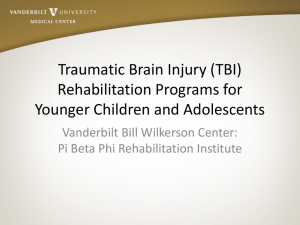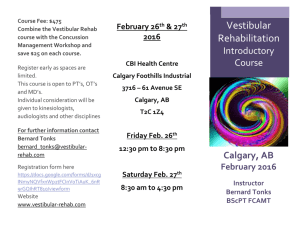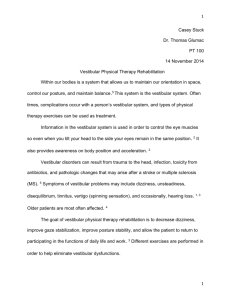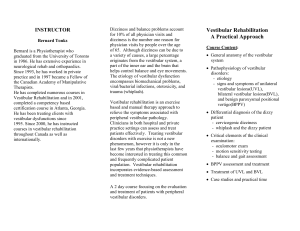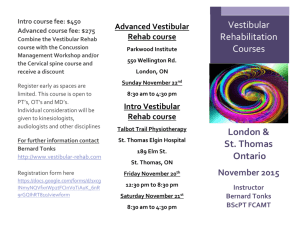How to Manage a Dizzy Patient - The Chartered Society of
advertisement
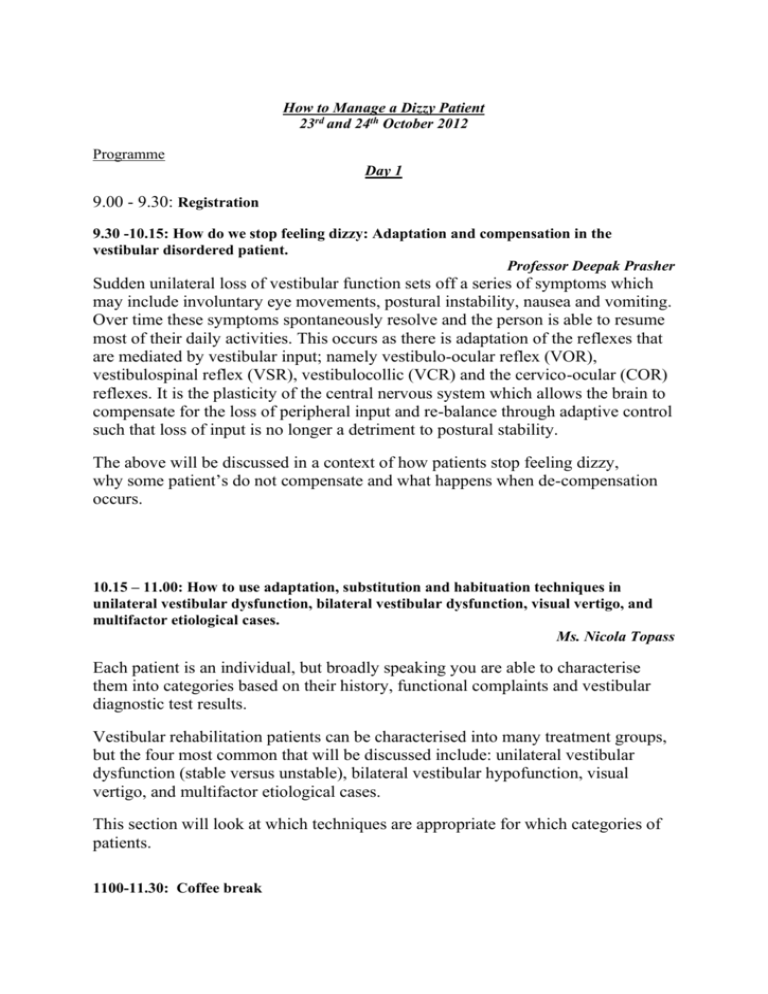
How to Manage a Dizzy Patient 23rd and 24th October 2012 Programme Day 1 9.00 - 9.30: Registration 9.30 -10.15: How do we stop feeling dizzy: Adaptation and compensation in the vestibular disordered patient. Professor Deepak Prasher Sudden unilateral loss of vestibular function sets off a series of symptoms which may include involuntary eye movements, postural instability, nausea and vomiting. Over time these symptoms spontaneously resolve and the person is able to resume most of their daily activities. This occurs as there is adaptation of the reflexes that are mediated by vestibular input; namely vestibulo-ocular reflex (VOR), vestibulospinal reflex (VSR), vestibulocollic (VCR) and the cervico-ocular (COR) reflexes. It is the plasticity of the central nervous system which allows the brain to compensate for the loss of peripheral input and re-balance through adaptive control such that loss of input is no longer a detriment to postural stability. The above will be discussed in a context of how patients stop feeling dizzy, why some patient’s do not compensate and what happens when de-compensation occurs. 10.15 – 11.00: How to use adaptation, substitution and habituation techniques in unilateral vestibular dysfunction, bilateral vestibular dysfunction, visual vertigo, and multifactor etiological cases. Ms. Nicola Topass Each patient is an individual, but broadly speaking you are able to characterise them into categories based on their history, functional complaints and vestibular diagnostic test results. Vestibular rehabilitation patients can be characterised into many treatment groups, but the four most common that will be discussed include: unilateral vestibular dysfunction (stable versus unstable), bilateral vestibular hypofunction, visual vertigo, and multifactor etiological cases. This section will look at which techniques are appropriate for which categories of patients. 1100-11.30: Coffee break 1130-12.30 How to create an individualized treatment plan Ms. Nicola Topass This section will discuss how to individualize a treatment plan to the needs of your patient and how to customize exercises within the technique category of adaptation, substitutions and habituation. The treatment plans should address techniques such as pacing and self-monitoring to ensure that the therapy program, exercises and level is set appropriately. It also teaches simplistic counselling techniques which are the corner stone of any successful vestibular rehabilitation program. Delegates are made aware of the differences of personal adjustment counselling versus informational counselling and how these counselling tools can be employed by an audiologist. 12.30 - 13.30 Lunch 13.30-14.15: How to manage a patient with BPPV Ms. Karen Lammaing Benign positional paroxysmal vertigo is one of the most common peripheral vestibular disorders and is often the most easily treated. BPPV is caused by movement of detached otoconia that have displaced into the semicircular canals. Treatment of BPPV involves the manipulation of the patient’s head to relocate these otoconia into the utricle where they can be reabsorbed. Identification of the involved canal is typified by specific eye movements when the patient is in the test position. It is important that the correct canal and correct side is identified as the treatment procedure is different for each of the 3 canals. Treatment for BPPV of the anterior, posterior and horizontal canal will be discussed and demonstrated. The delegate will have a good understanding on identifying which canal is involved and how to perform the different treatments. 14.15-15.00: How to optimise your therapy, beyond the use of physical exercises: use of bibliotherapy, goal setting, and motivation counselling in individualised therapy For any vestibular rehabilitation program to be successful it is important that the patient be motivated. A non-motivated patient will never improve no matter how much time or expertise is employed by the clinician. Therefore it is important to assess the motivation of the patient, be it via a simple conversation or by formally completing a motivation questionnaire such as the Multidimensional Health Locus of Control (MHLC) Scale. Once a patient is motivated then goals setting can be discussed. It is essential for the patient to have realistic goals or they set themselves up for failure, this is another corner stone concept for successful treatment. It is important that the clinician is able to listen to the patient and formulate appropriate goals with them. Studies have shown that patients only remember a small amount of what is actually said in any clinical interaction, and that is based on them having normal hearing. Thus our patients with balance and often hearing problems would remember even less. Thus it is important that all information is documented appropriately and that patients are directed to ‘safe’ internet sites for further reading to understand their condition. 15.00-15.30 How to assess the value of therapy: use of outcome measures. Ms. Nicola Topass The only way to ensure that the service you are providing your patients is beneficial is to measure that benefit. If you don’t measure it, it does not exist. There are two types of assessing benefit, namely by subjective assessment and by objective assessment. Subjective assessment can take place in the form of questionnaire assessment. There are several different outcome measurements available for vestibular rehabilitation from the more general SF 36 Health questionnaire to the more disease specific such as the Dizziness Handicap Inventory, Vertigo Symptom Scale and the Vestibular Rehabilitation Benefit Questionnaire (VRBQ). This section will focus on the VRBQ as it is a questionnaire that provides psychometrics. It is thus able to identify how much of a change pre-post therapy would be considered as a significant change due to the intervention offered. Objective assessment can be in the form of assessing postural sway. An example of an objective measure of postural sway is the EquiTest system by Neurocom. It enables the clinician to assess the increase in postural stability, decreased sway and increased limits of stability as the patient improves with the vestibular rehabilitation program. 15.30-16.15: How to manage the anxious and depressed patient and employ pacing and communication strategies. The use of psychological techniques in treating VR patients. Ms. Jacqui Seaton Anxiety and depression are closely linked with many chronic conditions, it is therefore no surprise that patient’s with vestibular disorders often have anxiety and depression. Stress, anxiety and depression are closely linked and can enhance dizzy symptoms and thus intern enhance the stress, anxiety and depression. It is a vicious cycle that can perpetuate itself and end in the patient being withdrawn from society. If the patient is in this anxiety state their ability to centrally compensate to their vestibular disorder is vastly diminished and they do not progress with their program. It is thus important that these patients be identified early and appropriate intervention is offered. This section will discuss how to identify these patients and the therapy programs that are currently offered for patients who have been identified. The therapy may be in the form of individualised intervention or group therapy depending on the needs of the patient. Some of the psychological concepts that will be discussed will include: acceptance and commitment therapy, pacing, defusion, and assertiveness. 16.15-16.45 Coffee 16.45- 17.15: The Vestibular Rehabilitation Process from the Patient’s Point of View Mr. Gordon Salter Mr. Salter had vestibular neuronitis in 2010. He sort help and was referred to the diagnostic Vestibular clinic at the Royal Surrey County hospital at which time he was diagnosed with peripheral right sided vestibular dysfunction. He was then referred to the Vestibular rehabilitation clinic in 2011. He did not spontaneously recover from this episode and it subsequently greatly affected his quality of life. He started the vestibular rehabilitation program in September 2011. He has been determined in his therapy outcomes and will inform us of his journey. 18.00-20.00: Evening break out session and dinner: Evening break out session to include: MCQ on topics of the day to test the basic understanding of topics discussed. Group breakout sessions on topics for further discussion. A chance to network with other members of the seminar as well as the lecturers. Day 2 9.00 – 11.00: How to use bedside tests to identify treatment goals and also use them to identify progress with therapy plans: Putting the key elements of a vestibular rehabilitation plan into practice with practical hands on session. Ms. Nicola Topass Bedside tests can be used as objective measures to assess uncompensated vestibular lesions. Post-head shake nystagmus is able to identify if there is tonic asymmetry at the level of the vestibular nuclei, hence depicting a centrally uncompensated lesion. The Fukuda stepping test evaluates the vestibular spinal reflex giving insight into how the vestibular system affects postural stability. Dynamic visual acuity is a measure of the VOR, and provides us with information of how vision with head movement may be affected due to the vestibular deficit. The Motion Sensitivity Quotient can be employed to quantify the degree of motion sensitivity the patient is experiencing. All of these measures would initially identify the uncompensated lesion and how it affects various reflex systems which are dependent on vestibular input. They would also change as the patient’s vestibular system compensates, hence improving as a measure of vestibular rehabilitation. The Fukuda would give insight for the need for stability exercises; the DVA would identify the need for Herman VOR exercises, and the MSQ would identify the need for habituation exercises such as the Cawthorne-Cooksey exercises. These tests will be demonstrated in a practical session. It will be shown how to use these tests to identify, implement and modify an exercise program. 11.00-11.15: Coffee break 11.15 – 12.15: Machine based VR practical Ms. Nicola Topass Most vestibular rehabilitation is based on clinical assessment of benefit of the VR therapy. The Machine based VR looks at the use of the Neurocom Balance Master platform for assessment improvement in postural stability and sway patterns with the progression of VR exercise therapy programs. It provides an objective measure of the patient’s improvement, which also serves as a motivational tool. The session will focus on how to use the principles that were taught in the Individualised VR practical with the machine based technology. 12.15 – 13.15: Lunch 13.15-15.15: BPPV assessment and management practical Ms. Karen Lammaing The techniques for BPPV assessment and management will be demonstrated practically. Techniques included will be: □ □ □ □ □ □ □ □ □ □ □ Dix-Hallpike Side Lying Roll Test Modified Epley Semont Brandt-Daroff BBQ roll Appiani Cassani Gans Manoeuvre Gufoni 15.15-15.30: Coffee break 15.30-16.30: Support groups for successful treatment of vestibular patients Ms. Natasha Harrington-Benton Director, Ménière’s Society Synopsis “When I was diagnosed with Ménière's I felt completely abandoned. Nobody told me of your Society and I felt lost…after searching the internet I have found you, and just to know that someone understands and I am not alone has made a world of difference.” The Meniere’s Society is the only UK registered charity dedicated solely to supporting people with dizziness and imbalance from vestibular disorders. The Society offers support at all stages of a person’s condition. For those who are newly diagnosed and want help locating a health professional who specialises in vestibular disorders, through to those in the later stages of the condition or if their symptoms have returned after a period of remission. Peer support, whether one-to-one, in a group, by telephone or online, plays an important part in the management of vestibular disorders and is often a valuable tool. The Ménière’s Society can give support and information and put people in contact with others facing the same problems. Knowing they are not alone and others share their concerns can be an enormous help to them in the management of their symptoms. Ménière’s Society The Ménière’s Society is a UK registered charity dedicated to supporting people with dizziness and balance problems caused by vestibular disorders. The Society provides information to patients and those who care for them, health professionals and the general public. Members are from all over the UK, with a small number overseas. With over 25 years experience providing information to those affected by vestibular disorders, the Ménière’s Society helps people source specialists in their local area, publishes a quarterly magazine, Spin, and factsheets on a variety of subjects (e.g. driving, surgery and vestibular rehabilitation), as well as providing a telephone information line during working hours. For health professionals, the Society offers information and support for their patients, we are able to supply booklets on vestibular rehabilitation and provide a list of ENT and vestibular rehabilitation specialists; useful if referring a patient for further testing and treatment. The Society maintains an active relationship with interested clinicians and researchers and, where funds allow, funds vital research into vestibular disorders. 16.30-17.00: VR case studies from a Physiotherapy Perspective Ms. Michelle Dawson Michelle is going to present a variety of case studies of patients who have undergone vestibular rehabilitation with a physiotherapy bias. Michelle is part of the vestibular rehabilitation MDT and was kindly invited to attend last year’s excellent study day and would highly recommend this informative study day. 17.00-17.30 VR cases studies from an Audiology Perspective Ms. Nicola Topass Nicola is going to present a variety of cases studies of patients who have received vestibular rehabilitation. It will focus on their therapy program from an audiological perspective. 17.00-18.00 Evening break out session: MCQ, BPPV Practical questions, or Machine based VR questions. Delegates will have the opportunity to choose from either: 1. A multiple choice question and answer session on all the topics that were discussed during the 2 day seminar. 2. Further session on question and answer session focused on BPPV assessment and management. 3. Or a further question and answer session on the machine based approach for VR. Outcomes for 2 day training: Upon completion of the course, participants should be able to: Understand the concepts behind vestibular reflex pathway adaptation and central compensation Identify the canal and side involved with BPPV and treat the patient appropriately Know how to classify a patient into treatment categories and how to identify exercise types based on those categories Understand how to develop an individualised vestibular rehabilitation program Understand the importance of outcome measures and how they could influence your therapy program Understand how to use bibliotherapy, goal assessment, and motivation in your vestibular rehabilitation program Understand how to employ psychological concepts in your vestibular rehabilitation program Understand the potential benefit of machine based vestibular rehabilitation Understand the benefits of support groups Understand the patient’s journey through the vestibular rehabilitation process Details of speakers/lecturers Professor Deepak Prasher, BSc, Consultant Clinical Scientist (Audiology) Email: d.prasher@nhs.net Professor Prasher has recently moved from University College London (UCL) Ear Institute where he was Head of the School of Audiology. He is the Chief Examiner for the Hearing Aid Council, Editor-in-Chief of the International Journal of Noise and Health, on the Board of Trustees for the National Deaf Children’s Society (NDCS). He has been an advisor to the European Commission and the World Health Organisation on matters of hearing and environmental noise issues. His interests are in special tests of hearing and balance. Ms Karen Lammaing - Deputy Head of Audiology (Adults) Karen Lammaing is the Deputy Head of Audiology and the clinical lead for Adult services in the Audiology Department at the Royal Surrey County Hospital. She was born in Belgium and completed her MSc in Audiology at the University of Ghent (Belgium). She has worked in the UK since 2003 and has worked in several Audiology Departments across the country. She joined the Audiology Department at the Royal Surrey County Hospital in 2010 and completes vestibular evaluations on a daily basis alongside her duties as Deputy Head. Ms Nicola Topass - Team Leader (Balance Service) Nicola Topass qualified as an Audiologist in 2004 and has been working at the Royal Surrey County Hospital since 2006. She is currently completing the Doctor of Audiology program with Nova Southeastern University on a part-time basis. She has special interests in Vestibular assessment and rehabilitation, but also does work with hearing assessment in Special needs adults, other Physiological Measures, Baha assessments and fittings and adult hearing assessments and fittings. She was appointed the Team Leader for the AudioVestibular service in 2009 and completes vestibular evaluations on a daily basis. Ms. Jacqueline Anne Seaton- Chartered Clinical Psychologist Jacqui joined the Vestibular rehabilitation Team in 2011 and worked closely with the team to develop psychological interventions appropriate for vestibular rehabilitation patients. She offers both individual therapy sessions in which she uses a holistic approach to patient therapy and draws from her many years of experience working with patients who are poorly motivated and have avoidance behaviours. She also offers educational group therapy which is part of the basic intervention program offered at the Royal Surrey County Hospital. These groups focus on the psychological concepts of pacing and communication tactics. Ms. Natasha Harrington-Benton Natasha Harrington-Benton is Director at the Ménière’s Society and has held this post for seven years. Natasha is responsible for the day to day running of the Ménière’s Society. Her role involves a wide range of activities including fundraising, strategy, publicity, attending events and liaising with health professionals, researchers and related organisations; as well as remaining a hands-on member of the office team, responding to enquiries and taking calls on the Society’s information line. Natasha has 18 years experience of working in the voluntary and not-for-profit sector and has previously worked for the Historic Churches Preservation Trust, The Industrial Society and Authors’ Licensing and Collecting Society. Ms. Michelle Dawson Michelle Dawson is a senior Physiotherapist who has worked at the Royal Surrey County Hospital since 2002. Michelle is a Musculoskeletal Physiotherapist who has developed skills in vestibular rehabilitation. Michelle is a member of the special interest group the ACPIVR (Association of Chartered Physiotherapists in Vestibular Rehabilitation) and attends regular update courses. Mr. Gordon Salter Mr. Salter is a vestibular rehabilitation patient.

